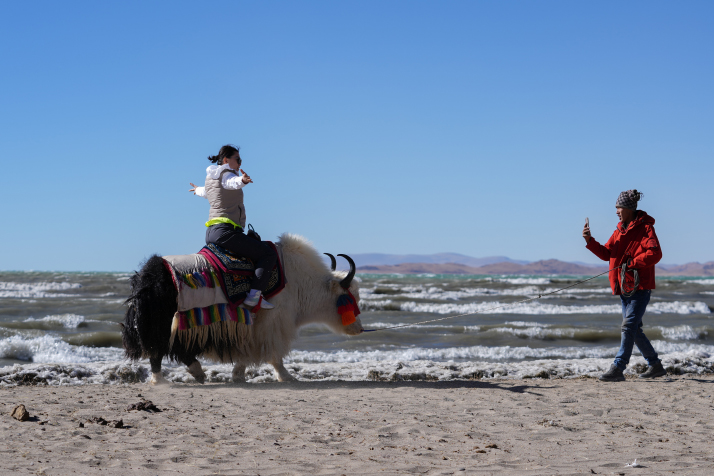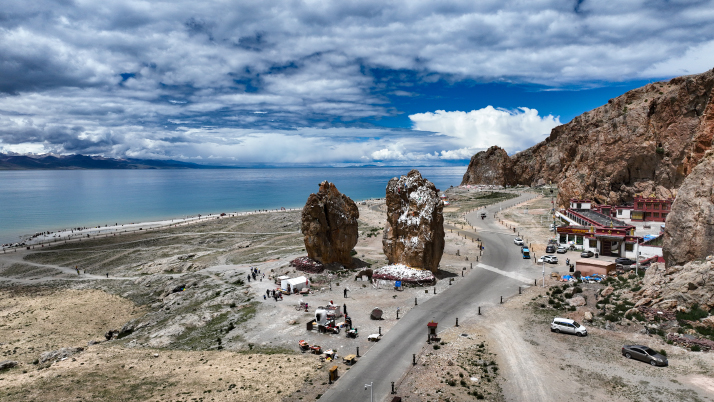| China |
| Nurturing Nature in Namtso | |
| Lakeside residents reap the rewards of ecological stewardship | |
|
|
 A tourist poses for pictures on a yak by Namtso Lake, Damxung County, Xizang Autonomous Region, in December 2024 (XINHUA)
Located in Xizang Autonomous Region at an altitude of 4,718 meters, Namtso Lake is the world's highest saltwater lake. In recent years, development has been occurring here in harmony with nature through a number of ecological protection and green development practices. Waste management On the shore of Namtso, the residents of Dabu Village in Damxung County, Lhasa City, now pack their household garbage into bags and stack them at a designated garbage collection point at the village entrance. Their garbage is taken from the collection point to the county's central disposal point. Lhasa Namtso Scenic Area Protection and Development Co. Ltd. also conducts daily patrols around the lake to ensure its environment is free from litter. "It wasn't like this a few years ago," recalled Dawa Dorje, a leader of Dabu Village. "We nomadic people have the tradition of living wherever there's water and grass. Our villagers used to have a weak awareness of ecological protection. When making seasonal movements between summer and winter pastures, we often built shelters randomly and threw away garbage at will. Additionally, especially after the year 2000, the number of tourists has begun to increase, garbage could be seen everywhere, and vehicles would drive across the grasslands, placing huge pressure on ecological protection." In 2016, an environmental inspection led authorities to begin addressing these pressures. "Namtso is a typical closed plateau lake system. To protect its ecosystem, we have launched special environment sanitation campaigns along the tourist route," said Gyatso, Director of the Damxung County Administration of the Namtso Nature Reserve. "We have established a garbage management mechanism of 'collection at the village, transport by the town and disposal by the county,' and sewage is also collected through septic tanks and then transported out for disposal, thus achieving zero pollution discharge within the scenic area." Tourists used to be allowed to drive into the core scenic area of Namtso, placing increasing pressure on the environment through littering and damage to the grasslands. In 2019, 60 electric shuttle buses were introduced to the scenic area, removing the need for visitors to drive their own vehicles. This has remarkably reduced vehicle emissions and the dispersal of garbage.  Namtso Lake and its lively surroundings on July 16 (XINHUA)
From sandy land to oasis Environmental activities being undertaken around the lake include both protection and restoration. According to Gyatso, 31 households, 107 stores and 45 temporary stalls have relocated away from the lake's core ecological area to mitigate the impact of human activities. At the same time, reseeding and other methods are being used to restore the grasslands around the lake and combat desertification. "We have also developed a plan to protect the lake's shorelines, prohibiting activities such as sand mining and illegal construction on its shores, and strengthening the protection and management of the waters and shorelines," Gyatso added. Ecological protection and restoration efforts like these, as well as the introduction of policies to balance raising livestock and protecting the grasslands, have been effectively improving the environment around the lake. The lake surface area has increased from 1,963 square km to 2,015 square km, and the water volume has increased from 81.69 billion cubic meters to 86.38 billion cubic meters. To further inspire villagers' enthusiasm for participating in ecological protection, the local government has also established positions such as grassland supervisors and ecological supervisors, providing more job opportunities while increasing ecological oversight. "During peak tourist season, they will increase the frequency of patrols and dissuade tourists from entering wetlands and trampling on grasslands," Gyatso said. Sharing ecological dividends While the ecological protection of Namtso requires the participation of the local herders, they are also the primary beneficiaries of its dividends. In Dabu Village, many delightful changes have taken place in villagers' lives. Dador and his family, for example, used to live in a black tent woven from yak hair. "The tent couldn't keep out the wind and it was difficult for us to endure in winter," he said. Now they have moved into a renovated Tibetan-style house, which retains distinctive Tibetan cultural elements and was built with environmentally-friendly, fireproof and earthquake-resistant materials. "The house requires no foundation and no cement was used. It is environmentally friendly and very solid, and we don't need to worry about wind or snow anymore," Dador said. As the ecological environment continues to improve, the lake is attracting more and more tourists. Herders who used to make a living by herding now have the "golden rice bowl" of ecotourism. "In 2016, we established a cooperative with nearby villages, which can provide over 100 job opportunities every year. Also, the business income of the cooperative has been increasing year by year. Now, each villager receives an average annual dividend of over 1,000 yuan ($140)," said Dador. "I am from a herding family, and I've been working at the scenic area for eight years. I have a fixed income every month and my life is much better than before," another resident, Chemi Yongzom, said. In addition to a better material life, the continuous improvement of Namtso's ecological environment has also brought cultural enrichment to local people. Here, as the ecosystem continues to improve and humans and nature coexist more harmoniously, the number of wild animals is increasing. "Wild animals I had never seen before, like bears and black-necked cranes, are now frequently seen and the grass is growing well," Dador said. "All these transformations are related to ecological protection." The author is a reporter with China Today magazine Copyedited by G.P. Wilson Comments to yanwei@cicgamericas.com |
|
||
|
||||||||||||||||||||||||||||
|